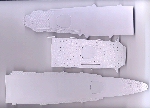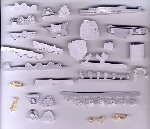| KazusaMinato
Naval Yard 1/500 HIJMS Taiho
Review by Felix Bustelo The Taiho was the largest purpose-built Japanese aircraft carrier and was similar in overall size to the United States Navy Essex class ships. However, the Taiho had two-story hangar decks and was the first Imperial Japanese Navy carrier to be constructed with an armored flight deck. The Taiho's design was developed from the Shokaku and she incorporated a number of features not found in that ship. Most notable of those was the sponsoned-out island with a trunked-in angled out funnel. The Taiho had a "hurricane" bow plated up to the flight deck level - a feature that the Essex class would not have until the 1950's. The Taiho's dimensions were 832.5 feet long overall with a beam of 91feet and a draft of 31feet 3 inches. The flight deck measured 863 feet long and 98.5 feet wide and she displaced 37,720 tons full load. The Taiho's armament consisted of 12 3.9 inch guns in 6 twin mounts, 71 25mm machineguns and 22 13mm machineguns. She could carry as many as 85 aircraft but in actuality she carried about 60. As advanced as the Taiho was, she had only a brief career. She was completed in March 1944 and after her shakedown cruise was deployed to the Battle of the Philippines Sea. On June 19 she was hit by one torpedo from the submarine USS Albacore. Several hours later she suffered a massive fatal explosion when fuel vapors ignited, probably due to negligence or poor damage control procedures. The KazusaMinato Naval Yard 1/500 scale resin kit of the Taiho is the largest model kit of this carrier. This kit has some similarities to the other KazusaMinato Naval Yard kits and it has some minor differences. Unlike the other kits, the Taiho can be constructed only as a full-hull models (the other kits have a waterline option). Like the other kits, the hull is built-up by stacking various deck sections. With the Taiho, the lower hull is one piece - the midsection with the hangar decks and other workspaces is comprised of separate forward and aft sections. The flight deck is also comprised of separate forward and aft sections. Dry fitting the hull pieces reveal that filling and sanding is required to hide seams in the joints. This will be especially trying where the flight deck sections meet. In my sample, the deck levels have a significantly warped and will need to be straightened out after a softening them up in a hot water bath. The vertical details are very well done on these hull sections. The flight deck is nicely detailed and there is an option to model one or both of the elevators in the lowered position. The latticework supports underneath the overhang sections in the open stern boat deck and gun sponsons are very well done. The various openings in the vertical surfaces will need to be opened up by removing the thin film of resin that covers them. There are some vertical surface details, like vents and raised rectangles to represent access doors, but there are no portholes. The latter will need to be drilled out by the modeler using plans to denote locations. The hull pieces have a resin casting plugs that need to be sanded smooth. The smaller parts include the various sponsons, island and island deck levels, funnel, the 3.9 inch twin mounts, directors, anchors, rudders, propellers and shaft supports. The casting of the smaller parts is good and the island sections actually have the portholes drilled out. The 3.9 inch twin mounts do not come with the gun barrels so you will need to use brass rod or tubing to make these. Similarly to the other KazusaMinato Naval Yard offerings, the model does not come with the boats, aircraft, secondary anti-aircraft guns and searchlights. Based on what I can determine from their website, I think that the kit was supposed to come with the boats but for some reason they were excluded from my sample. The aircraft and anti-aircraft guns are sold separately but I am not sure if they are being developed or are in fact available. You may want to raid some Nichimo kits for parts or make home resin castings from these parts for use on this model. The kit also does not come with photoetch parts. You can 1/500 scale IJN Carrier sets from Gold Medal Models or Tom's Modelworks to detail this kit. The instructions are comprised of three sheets in Japanese, but with adequate visuals to help overcome the language barrier. Images of the kits parts are mapped to a numbered key appear on the first page. This serves as a cross-reference to exploded diagrams of the subassemblies on the second page. If there are any painting references or assembly notes I cannot tell as they are in Japanese if they are present. While the assembly instructions are a good basis, I would highly recommend acquiring other reference materials. Gakken Publications Volume #22 provides excellent photographic references and good plan line drawings of the Taiho and Shinano. This book contains a series of photos of a superb built-up version of this actual kit as part of the visual references - what more could you ask for? Pacific Front Hobbies carries a line of plans produced by Miyukikai (Myco) and they have plans for the Taiho as she appeared in 1944 in 1/350 scale. If I had to sum this kit up, I would describe it as a "builders"
model, which is a term I think is used for kits which provide you with
the basics but requires some scratchbuilding and photoetch from other sources
to complete. If you are a fan of Imperial Japanese Navy subjects and are
looking for something new in 1/500 scale then you would consider buying
this kit. The price tag is hefty, with 35,000 Yen converting to about $262
US depending on the exchange rate. For this price, I would have expected
that the omitted items such as the boats, airplanes and anti-aircraft guns
and some photoetch to be included. This model has the potential to be made
into an excellent model, just look at the Gakken Publications book I mentioned
above, but it will require looking for alternative sources for or scratchbuilding
the missing parts and it will test your modeling skills. My thanks to KazusaMinato
Naval Yard for providing this review sample.
Click on thumbnail for a full-size picture |


